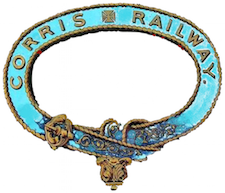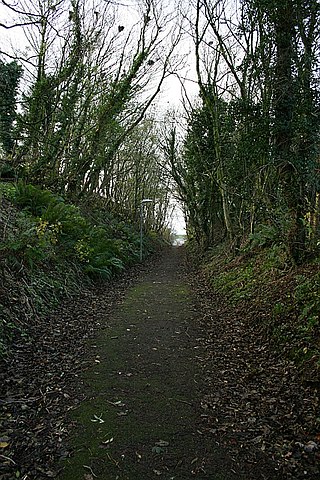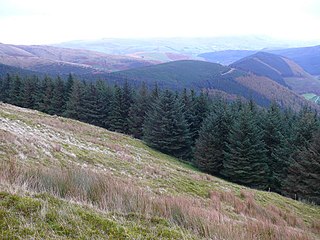
The Corris Railway is a narrow gauge preserved railway based in Corris on the border between Merionethshire and Montgomeryshire in Mid-Wales.

The Talyllyn Railway is a narrow-gauge railway in Wales running for 7+1⁄4 miles (12 km) from Tywyn on the Mid-Wales coast to Nant Gwernol near the village of Abergynolwyn. The line was opened in 1865 to carry slate from the quarries at Bryn Eglwys to Tywyn, and was the first narrow gauge railway in Britain authorised by Act of Parliament to carry passengers using steam haulage. Despite severe underinvestment, the line remained open, and in 1951 it became the first railway in the world to be preserved as a heritage railway by volunteers.

The Cambrian Railways owned 230 miles (370 km) of track over a large area of mid Wales. The system was an amalgamation of a number of railways that were incorporated in 1864, 1865 and 1904. The Cambrian connected with two larger railways with connections to the northwest of England via the London and North Western Railway, and the Great Western Railway for connections between London and Wales. The Cambrian Railways amalgamated with the Great Western Railway on 1 January 1922 as a result of the Railways Act 1921. The name is continued today in the route known as the Cambrian Line.
The Plynlimon and Hafan Tramway was a 2 ft 3 in gauge narrow gauge railway in Cardiganshire in Mid Wales. It ran from Llanfihangel station on the Cambrian Line, through the village of Tal-y-bont and the valley of the Afon Leri, into the foothills of Plynlimon Fawr. It was built to serve the lead mines at Bwlch Glas and stone quarries around Hafan and opened in 1897, closing just two years later. The line was a little over 7 miles (11 km) long and, despite running a short-lived passenger service, it served no communities of more than 100 people.

The Hendre-Ddu Tramway was a 1 ft 11 in narrow gauge industrial railway built in 1874 in Mid-Wales to connect the Hendre-Ddu slate quarry to Aberangell station on the Mawddwy Railway. It consisted of a main line 3+1⁄2 miles (5.6 km) long and several branch lines and spurs serving other quarries, local farms and the timber industry.

The Kerry Tramway was a 2 ft narrow gauge railway built in 1887 to serve the timber workings and slab quarry to the south of the village of Kerry, near Newtown in mid Wales.
James Ian Craig Boyd was an English author and narrow-gauge railway historian.
The Mawddwy Railway was a rural line in the Dyfi Valley in mid-Wales that connected Dinas Mawddwy with a junction at Cemmaes Road railway station on the Newtown and Machynlleth Railway section of the Cambrian Railways.

Sir Haydn is a narrow gauge steam locomotive, built by Hughes's Locomotive & Tramway Engine Works, Loughborough in 1878. It operated on the Corris Railway in Wales, until closure in 1948, and since 1951 has operated on the nearby Talyllyn Railway. It has carried the operating number 3 under four successive owners.

Edward Thomas is a narrow gauge steam locomotive. Built by Kerr Stuart & Co. Ltd. at the California Works, Stoke-on-Trent in 1921, it was delivered new to the Corris Railway where it ran until 1948. After that railway closed, the locomotive was brought to the Talyllyn Railway in 1951, then restored, and remains in working order at the heritage railway. It has carried the operating number 4 under four successive owners.

Campbeltown was a railway station in the town of Campbeltown, Argyll and Bute, serving the town and ferry terminal. The Campbeltown and Machrihanish Light Railway was a 2 ft 3 in (686 mm) narrow gauge railway in Kintyre, Scotland, between the towns of Campbeltown and Machrihanish. Plantation Halt was the next stop on the line.
Machrihanish was a railway station in the village of Machrihanish, Argyll and Bute, serving the town. The Campbeltown and Machrihanish Light Railway was a 2 ft 3 in (686 mm) narrow gauge railway in Kintyre, Scotland, between the towns of Campbeltown and Machrihanish.
Lintmill Halt was a railway station about two miles (3 km) from Campbeltown, Argyll and Bute, serving the rural locale and the nearby lint mill. The Campbeltown and Machrihanish Light Railway was a 2 ft 3 in (686 mm) narrow gauge railway in Kintyre, Scotland, between the towns of Campbeltown and Machrihanish.
Trodigal Halt was a railway station situated at the road crossing near East Trodigal Farm and close to Machrihanish, Argyll and Bute. The Argyll Colliery with its rail connection was nearby. The Campbeltown and Machrihanish Light Railway was a 2 ft 3 in (686 mm) narrow gauge railway in Kintyre, Scotland, between the towns of Campbeltown and Machrihanish.
Drumlemble Halt was a Scottish railway station situated at the road crossing near East Drumlemble Farm on a lane to Lochsanish Farm, Argyll and Bute.
Moss Road Halt was a railway station situated at the road crossing on the road that runs across Aros Moss. Argyll and Bute.
Plantation Halt was a railway station situated near the road crossing on the A83 at a small plantation that is no longer extant. Argyll and Bute.
Minllyn quarry was a slate quarry near Dinas Mawddwy in Wales that opened before 1793 and continued working intermittently until 1925. The quarry is located on the western flank of Foel Dinas.

Mynydd Gartheiniog is a mountain in southern Snowdonia, Wales. It is a long ridge running south from the cliff of Craig Portas above Dinas Mawddwy and parallel to Mynydd Dolgoed which lies to the west.









